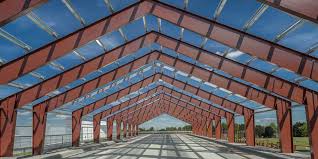Red iron construction has become a cornerstone of modern building projects due to its durability, versatility, and cost-effectiveness. From commercial warehouses to industrial facilities, the use of red iron steel frames provides a strong foundation that supports large-scale structures while allowing for efficient construction timelines. This article explores the key aspects of red iron construction, including its benefits, applications, design considerations, and maintenance practices, helping builders, architects, and project managers make informed decisions.
What is Red Iron Construction?
Red iron construction refers to the use of structural steel beams and columns, typically coated with a red oxide primer for protection against corrosion during storage and transit. The term “red iron” comes from this distinctive red primer rather than the steel itself.
Key Components of Red Iron Construction
- I-Beams and H-Beams: Main structural elements that provide vertical and horizontal support.
- Columns: Vertical supports that carry the building’s load.
- Girders and Joists: Horizontal supports connecting beams and columns.
- Red Oxide Primer: Protective coating that prevents rust and facilitates welding and fabrication.
Advantages of Red Iron Construction
- Strength and Durability: Red iron steel can withstand heavy loads, wind, and seismic activity.
- Flexibility: Allows for open floor plans and customizable layouts.
- Speed of Construction: Prefabricated steel beams accelerate the building process.
- Cost-Effectiveness: Reduced labor costs and minimal material waste make it an economical choice.
Applications of Red Iron Construction
Commercial Buildings
Retail spaces, office buildings, and shopping centers often rely on red iron construction due to the strength of steel frames and the flexibility to create large, open areas without interior columns.
Industrial Facilities
Factories, warehouses, and distribution centers benefit from red iron construction because it supports heavy machinery, high ceilings, and wide spans, making the space functional and efficient.
Agricultural Structures
Barns, storage sheds, and other agricultural buildings use red iron frames for durability and resistance to harsh weather conditions.
Recreational and Institutional Buildings
Gyms, sports arenas, schools, and community centers often use red iron construction to achieve large open spaces and long-lasting structures.
Design Considerations in Red Iron Construction
Load Calculations
Proper load analysis is essential in red iron construction. Engineers must consider dead loads (weight of the structure itself), live loads (occupants and furniture), and environmental loads (wind, snow, and seismic forces) to ensure structural safety.
Span and Clearance
Red iron steel beams allow for long spans without intermediate supports, providing flexibility in interior layouts. Architects should consider ceiling heights and functional space requirements when designing steel-framed buildings.
Connection Methods
- Welded Connections: Provide rigid joints but require skilled labor.
- Bolted Connections: Easier and faster to assemble, allowing for modular construction.
Corrosion Protection
Although red iron primer provides temporary protection, proper painting, coating, or galvanization ensures long-term durability, especially in humid or industrial environments.
Benefits of Red Iron Construction
Strength-to-Weight Ratio
Steel offers a high strength-to-weight ratio, meaning red iron construction can support large loads with less material, reducing foundation costs.
Faster Construction Time
Prefabricated steel beams arrive ready to install, allowing construction teams to assemble structures quickly and efficiently. This speed reduces labor costs and accelerates project timelines.
Design Flexibility
Architects can create innovative designs, including multi-story buildings, open floor plans, and cantilevered sections, thanks to the versatility of steel frames.
Sustainability
Steel is recyclable and reusable, making red iron construction an environmentally responsible option for modern buildings.
Common Challenges in Red Iron Construction
Initial Cost
While long-term savings are significant, the upfront cost of red iron steel and fabrication may be higher than traditional wood or concrete construction.
Skilled Labor Requirement
Welding, bolting, and assembly of steel structures require trained professionals to ensure safety and structural integrity.
Corrosion Risks
If protective coatings are damaged or improperly applied, red iron steel can corrode over time, necessitating regular inspection and maintenance.
Noise and Insulation
Steel conducts sound and heat differently from other materials. Proper insulation and soundproofing must be incorporated into red iron construction projects.
Maintenance of Red Iron Buildings

Regular Inspections
Routine inspections help detect rust, loose bolts, or structural damage early, preventing costly repairs.
Protective Coatings
Applying weather-resistant paints or sealants prolongs the lifespan of red iron steel, protecting it from corrosion.
Structural Adjustments
Over time, modifications may be needed to accommodate new equipment, additional floors, or renovations. Red iron construction allows for flexible adjustments without compromising the building’s integrity.
Red Iron Construction vs. Other Building Methods
Compared to Wood
- Strength: Steel outperforms wood in load-bearing capacity.
- Durability: Steel resists pests, fire, and decay better than wood.
- Flexibility: Red iron allows for larger spans without interior supports.
Compared to Concrete
- Speed: Steel frames are faster to erect than poured concrete.
- Weight: Steel is lighter, reducing foundation costs.
- Reusability: Steel components can be recycled, whereas concrete is less reusable.
Compared to Modular Construction
While modular buildings offer speed, red iron construction provides unmatched strength, design flexibility, and the ability to accommodate larger industrial and commercial spaces.
Innovations in Red Iron Construction
Prefabrication and Modular Steel
Modern red iron construction often uses prefabricated beams and modular components, allowing for faster assembly and reduced on-site labor.
Advanced Coatings
Innovative anti-corrosion coatings and galvanization techniques extend the lifespan of steel frames in harsh environments.
Sustainable Design
Engineers are increasingly integrating energy-efficient features such as insulation panels, green roofs, and solar-ready designs into red iron structures.
Smart Building Integration
Modern red iron buildings can easily incorporate technology such as HVAC systems, automated lighting, and structural monitoring for long-term efficiency and safety.
Conclusion
Red iron construction is a versatile, strong, and efficient building method that has transformed modern architecture and industrial construction. Its combination of durability, design flexibility, and cost-effectiveness makes it an ideal choice for commercial, industrial, agricultural, and recreational buildings. While it requires skilled labor and proper maintenance, the long-term benefits of red iron construction—including sustainability, speed, and structural integrity—outweigh the challenges. Whether you are planning a large warehouse, a multi-story commercial building, or a customized industrial facility, red iron construction provides the strength and adaptability needed to bring ambitious projects to life.





